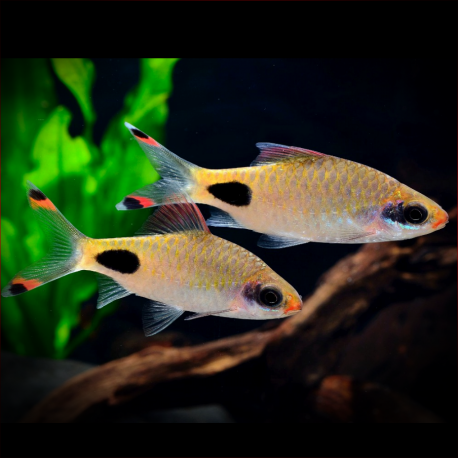More info
Datasheet
| Minimum Tank Size | 240 litres / 63.40 US gallons |
| Maximum Size | 12.0cm / 4.72inches |
| Temperature | 19°C / 66.20°F - 25°C / 77.00°F |
| Hardness | 2.02dgH / 36ppm - 10.03dgH / 179ppm |
| pH | 6.0-7.0 |
General Description
Dawkinsia Assimilis, formerly known as Puntius assimilis, is a small fish belonging to the Cyprinidae family. It exhibits a unique combination of characteristics such as absence of rostral barbels, presence of maxillary barbels, and distinctive color patterns. The species typically reaches a maximum size of 12.0cm in length and is an omnivorous forager in its natural habitat.
Aquarium Setup
Setting up an aquarium for D. assimilis involves replicating a riverine environment with a substrate of rocks, sand, and gravel. Driftwood, roots, or branches can be added for decoration, along with hardy aquatic plants like Microsorum and Anubias species. The fish thrive in pristine water conditions with high oxygen levels and moderate water movement. Regular water changes of 30-50% tank volume are recommended.
Behaviour
As a schooling species, D. assimilis prefers to be kept in groups of 8-10 individuals. It displays hierarchical behavior within the group, with males focusing on maintaining their positions. When housed with peaceful larger fish, it typically remains non-aggressive. However, compatibility should always be researched thoroughly to prevent any issues in community tanks.
Feeding and Diet
In the wild, D. assimilis feeds on worms, insects, crustaceans, and plant material. In aquariums, they readily accept a diet of small live and frozen foods such as bloodworms, Daphnia, and Artemia, supplemented with high-quality dried flakes and granules. A balanced diet promotes optimal health and vibrant colors in these fish.
Reproduction & Dimorphism
The breeding behavior of D. assimilis involves egg-scattering without parental care. A separate breeding tank with dim lighting and suitable breeding substrates is recommended for controlled breeding. Adult males develop more intense colors and tubercles on the head during spawning, while females grow larger and exhibit a less vibrant coloration.
Habitat and Distribution
Endemic to the Southwest Indian states of Karnataka and Kerala, D. assimilis inhabits various habitats depending on the specific locality. It has been found in marginal zones with sluggish flow, clear rocky stretches in flowing waters, and among granite boulders in shallow, slow-moving waters in river basins. The precise distribution of the species within its range is not yet fully understood.

